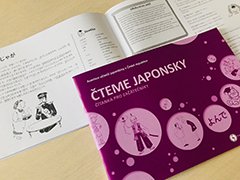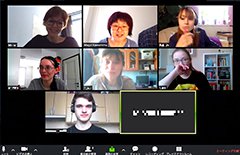My Impressions of the Japanese Teachers Association and Spring in 2020
Charles University
KAWASHIMA Makiko
In my last report for AY2019, the main focus was on support for Japanese-language education at Charles University where I am dispatched. In this report, I will focus on Japanese-language education in the Czech Republic (hereinafter “Czechia”) and the association of Japanese teachers in the country. I will also touch on the telecommuting situation that began in the spring of 2020.
The Association of Japanese Teachers
According to the Survey on Japanese-Language Education Abroad 2018, there are currently 1,246 learners of Japanese in Czechia, while 295 applicants took the 10th Japanese-Language Proficiency Test (JLPT) this year, with expectations for that number to exceed 300 in 2020.
The number of learners is primarily comprised of students at higher educational institutions, such as universities, but there are also many who study at private language schools and Japanese classes, as well as those who study online. The learners also cover a wide range of ages, from children to senior citizens. This diversity of learners is supported by the efforts of the many teachers involved in Japanese-language education, which itself is leading to a steady increase of learners.
For example, an annual Japanese speech contest is held in Czechia each year, and the 43rd such event was held in April 2019, making it one of the longest continuing contests in Central and Eastern Europe. Both the Japanese speech contest, and the JLPT held every December in Brno, are carried out under the management of the Association of Japanese Language Teachers in the Czech Republic. The first time I assisted in the two events, I was impressed by the fact that the management thereof was efficient and organized, and comprehensive care and attention was paid to all of the learners. However, this seemingly perfect preparation and organization did not happen overnight. I was told that “we have been improving through trial and error every year, and we’re not perfect yet.”

The Yonde teaching materials for
beginner’s reading comprehension published
by the Association of Japanese Language Teachers
The Association of Japanese Language Teachers in the Czech Republic has published a variety of teaching materials since it was founded in 2007. These include the Hiragana Text in 2007, the Katakana Text in 2010, and the Kanji Text in 2014. Finally, their teaching materials for beginner’s reading comprehension "Yonde" were published in their entirety in 2020. The materials introduce the fascinating differences between Japanese and Czech culture using cute illustrations, and were prepared with the aim of making learning fun. In fact, these textbooks published to date have also found acceptance by people other than Japanese learners, experiencing Japan’s language and culture for the first time. The recently published Yonde maintains this tradition. It is easy to imagine how the materials were carefully prepared by the Association of Japanese Language Teachers with detailed attention for the characteristics of the Czech people and their culture. It makes me feel that the driving force behind this unbridled affection and tireless effort shown by the teachers for their learners is in fact the unbounded joy they feel when those learners improve in their Japanese language abilities.
Further Challenges

A scene from an online class
Incidentally, a State of Emergency was declared in Czechia on March 12, 2020 due to the spread of the Covid-19 Pandemic. Numerous commercial and educational facilities were immediately closed, and it became impossible to hold classes in the classrooms. This occurred at the first half of the second semester according to the university’s calendar year, so we immediately began planning for online classes. The Japanese course at Charles University managed to complete the transition to online classes within one week, and that left us to continue them for about three months until the end of the academic year. Luckily, we did manage to almost complete the curriculum within that timeframe, and in between classes, I used my time to attend some of the online training that was quickly being implemented in both Japan and Europe so that I could apply what I learned there to my own online classes. While I learned many useful things in those training sessions, I also learned a great deal in my own classes, including in technical areas, as my students waited for me on occasion while I struggled with the online training tools.
One thing I understand now is that things go more smoothly if you remember that online classes cannot completely replace face to face classes. When schools were initially closed, many of the teachers, including myself, immediately began wondering whether we could offer online the same lectures as the offline classes. However, online and offline classes are not the same thing, because in a sense, you are taking the real three-dimensional world and making it flat. As I came to understand that, the way I prepared the teaching materials and classes began to change. Until then, I had only a vague idea of how digital technology could be applied, and had no clear picture of the different types available, but with this unexpected transition to online classes while working from home, I now see only the future potential for them. Currently, my colleagues and I are working hard to prepare the digital teaching materials for the next school year beginning in October 2020. Once completed, they will be teaching materials unique to this university.
- What We Do Top
- Arts and Cultural Exchange [Culture]
- Japanese-Language Education Overseas [Language]
- Japanese-Language Education Overseas [Language] Top
- Learn Japanese-language
- Teach Japanese-language
- Take Japanese-Language Test
- Know about Japanese-language education abroad
- The Japanese-Language Institute, Urawa
- The Japanese-Language Institute, Kansai
- Japanese-Language Programs for Foreign Specified Skilled Worker Candidates
- Japanese Language Education for Japanese Children Resident Overseas and for the Descendants of Migrants
- Archives
- Japanese Studies and Global Partnerships [Dialogue]
- JF digital collection
- Other Programs / Programs to Commemorate Exchange Year
- Awards and Prizes
- Publications
